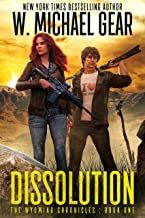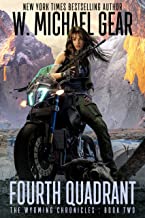Reviewed by Charles Curley
[email protected]
Attribute to L. Neil Smith’s The Libertarian Enterprise


Book One: Dissolution, 2021
Book Two: Fourth Quadrant, 2022
Wolfpack Publishing
There is a sub-genre of disaster novels called The End of the World As We Know It (TEOTWAWKI). Probably my all-time favorite here is Larry Niven and Jerry Pournelle’s plea for nuclear energy and space exploration, Lucifer’s Hammer (1997). All of them tout, openly or covertly, the Boy Scouts’ motto, Be Prepared. Those who survive The End of the World and prosper are those who are prepared for it. The cliche here is the macho sharp shooting hunter who has his rifle and .45, and thousands of rounds in his basement. But there are other ways of preparing: see Dr. Dan Forrester in Lucifer’s Hammer.
Into this venerable tradition comes W. Michael Gear, anthropologist and archaeologist by trade. He and Kathleen O’Neal Gear have written more than 60 books, many of them together. The Wyoming Chronicles tell a tale of Wyoming following a catastrophic banking collapse as the world’s credit card system comes to a screeching halt one Memorial Day Weekend. A archaeological field crew is on its way to a dig high up in Wyoming’s Owl Creek Mountains, and all of a sudden their credit cards won’t buy them gasoline. They make it to the town of Hot Springs, to the Tappan Ranch, where they meet their outfitters, and up to the dig site.
One of the more enjoyable aspects of The Wyoming Chronicles is the culture shock as a computer gamer, some New Yorkers, a daughter of the Washington elite, and other members of the east coast liberal elite meet and clash, first with each other, then with “red neck” ranchers (in a state that voted overwhelmingly for Donald Trump) and Shoshoni mysticism and mythology. Keep an eye on the guy on the cover of Dissolution wearing the “I 🖤 New York” T-shirt. For this and other reasons, the books are in part a meditation on character: what it is and how it affects what you do in a crisis. Gear is firmly in the “Competent Man” (and competent woman) tradition of E.E. Doc Smith, H. Beam Piper, John Campbell, and Robert Heinlein.
Much of the action in the first novel takes place in Wyoming’s Big Horn Basin: in and near the the archaeological dig, the Tappan Ranch, in the town of Hot Springs, and near Cody. The Gears have lived and ranched in Hot Springs County and now in Cody, and their experience and local knowledge come through in these novels.
Other parts occur in and near Cheyenne. Cheyenne is 100 miles from the Denver metropolis, which rapidly goes to hell in a hand basket. What does Wyoming’s governor do about the thousands of refugees streaming north on Interstate 25, and the thousands of marauders and raiders following them? We get a glimpse of this in Dissolution and see a lot more of it in Fourth Quadrant.
You never really know what you will do in a crisis. You can prepare for it all you want, but often the crisis isn’t what you planned on. What will you do then? The books are about that question, as characters are “stress tested” in the crucible of the dissolution of civilization. Civilization is fragile, as the recent supply line problems and increases in consumer prices show. But it’s also fragile in human beings. People can easily lose what Edgar Rice Burroughs called “the thin veneer of civilization”. It is also institutions: the rule of law can also dissolve quickly, as events in Venezuela, Iraq, Syria and other places show. Civilizations have collapsed before, as the historic and prehistoric records show.
The Wyoming Chronicles are two (so far) novels centered around disaster and recovery from disaster, with a distinct Wyoming flavor. Complete with cattle drive. Welcome to Wyoming.
Was that worth reading?
Then why not:
